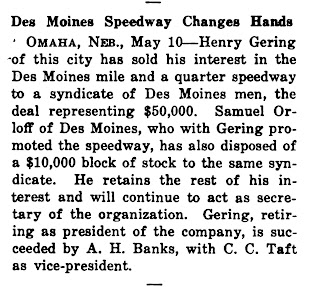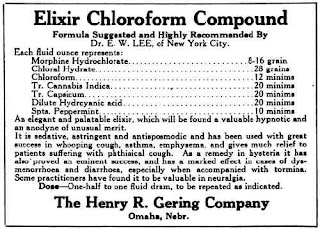 |
| Source: 1910 promotional booklet published by the Omaha Commercial Club |
As I mentioned, he was the managing trustee of the Western Medical Review, which was the official publication of the Nebraska State Medical Association, and in the very same volume containing the ads I discussed in my previous post, a report on the proceedings of the House of Delegates at the 46th Annual Meeting of said Medical Association revealed some friction on the subject of advertising in the Review. A complaint had been made by members of the Medical Association at the previous annual meeting that the Review, "in spite of the protests of the [Censoring Committee of the Association], continued to carry objectionable advertising," and a special committee (don't you love organizational life!) had been appointed to investigate.
Harsh words were said (actually, in today's political arena this would be considered pretty bland):
I was naturally avidly curious to find out what they considered "objectionable" to the point of disgust, but even after wading through the dense prose of the report I am not really much wiser. It seems they objected principally to 19 "proprietaries" advertised in the January and February 1914 issues of the Review, which were apparently frowned upon by the American Medical Association. (One of them was Glyco-Heroin, but presumably cannabis-containing products were fine.) They included such popular remedies as Sal Hepatica, Iodum-Miller, Fagisota (isn't that a great name?), and Sabalol Spray, but it's not clear what exactly the objections were. Henry Gering spoke on behalf of the Western Medical Review Company (incidentally, I believe his company had in the past advertised some of these shady products, but no one mentioned that), and he and the board of the Review responded to the objections in a letter. The Coca Cola ad was to be discontinued, as were a number of other censored ads. The Henry R. Gering Co. would no longer list dosages in its ads (maybe that was it? Information that would allow the public to bypass doctors? Except that these ads were directed at doctors). Mention was made of ads comparable to the disparaged ones that were still running in the august Journal of the A.M.A. Those included the White Cross Electric Vibrator, as well as Rat and Roach Paste...just thought I'd mention these intriguing products. Anyway, tempers were calmed, the militants subsided, and harmony and dignity reigned. I think medical advertising might be a great topic for someone's doctoral dissertation--maybe it already has been.
Well, I've already spent WAY too much time on the Western Medical Review. Otherwise I would go ahead and post its column of medical jokes (Vol. 16, No. 7, July 1911, p. 392), "Some German Medical Jokes." Anyone who thinks doctors have no sense of humor...must have read this column.
Tempted? Go check this out on Google Books!
Harsh words were said (actually, in today's political arena this would be considered pretty bland):
 |
| Western Medical Review, Vol. XIX, #7 (July 1914), p. 351; accessed at Google Books |
I was naturally avidly curious to find out what they considered "objectionable" to the point of disgust, but even after wading through the dense prose of the report I am not really much wiser. It seems they objected principally to 19 "proprietaries" advertised in the January and February 1914 issues of the Review, which were apparently frowned upon by the American Medical Association. (One of them was Glyco-Heroin, but presumably cannabis-containing products were fine.) They included such popular remedies as Sal Hepatica, Iodum-Miller, Fagisota (isn't that a great name?), and Sabalol Spray, but it's not clear what exactly the objections were. Henry Gering spoke on behalf of the Western Medical Review Company (incidentally, I believe his company had in the past advertised some of these shady products, but no one mentioned that), and he and the board of the Review responded to the objections in a letter. The Coca Cola ad was to be discontinued, as were a number of other censored ads. The Henry R. Gering Co. would no longer list dosages in its ads (maybe that was it? Information that would allow the public to bypass doctors? Except that these ads were directed at doctors). Mention was made of ads comparable to the disparaged ones that were still running in the august Journal of the A.M.A. Those included the White Cross Electric Vibrator, as well as Rat and Roach Paste...just thought I'd mention these intriguing products. Anyway, tempers were calmed, the militants subsided, and harmony and dignity reigned. I think medical advertising might be a great topic for someone's doctoral dissertation--maybe it already has been.
Well, I've already spent WAY too much time on the Western Medical Review. Otherwise I would go ahead and post its column of medical jokes (Vol. 16, No. 7, July 1911, p. 392), "Some German Medical Jokes." Anyone who thinks doctors have no sense of humor...must have read this column.
Tempted? Go check this out on Google Books!
By the way, anyone with a Nebraska doctor in his or her ancestry would do well to have a look at these early issues of the Western Medical Review--they had a nice little gossip column about the doings of doctors around the state.
I've sort of gotten off the topic of Henry. Besides his activities in the various state medical and pharmaceutical operations, he liked cars; he was part-owner of the Des Moines Speedway until he sold his interest in 1916 (probably just in time, going by the history at the Des Moines Speedway Page), as I learned from The Automobile (Vol. 34, #19, May 11, 1916, p. 875)--another fascinating periodical digitized at Google Books, but I will NOT let myself be seduced.
Obviously he was doing pretty well financially. The July 11, 1918, issue of the same journal reported that ground had been broken in Omaha on Florence Blvd. for the first factory building of the United States Carburetor Company, the president of which was--Henry R. Gering! The Atlantic News Telegraph of Aug. 28, 1913, reports that he was treasurer of the Rainey Mail Exchange Co. And on and on. The thought of all the committee meetings he must have attended gives me the horrors. Did the man ever stop to rest? I don't know how he had the time for any dalliance whatsoever with Mrs. Benjamin Redman--even just penning love notes. I guess he could have had his secretary do it....
And yet, amid all the wheelings and dealings, Henry still took the time to go home and carry out the somewhat unusual terms of his mother's will in 1920. I think this little article reflects so nicely on both Henry and his mother, I will close this rambling dissertation with it:
 |
| The Evening State Journal and Lincoln Daily News (Lincoln, NE), March 23, 1920, p. 1. |






